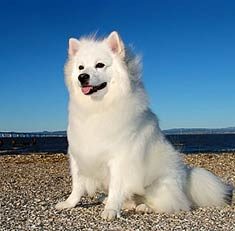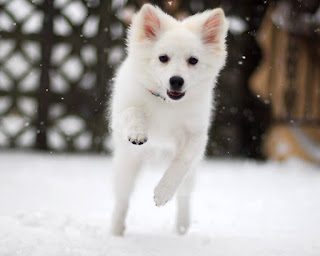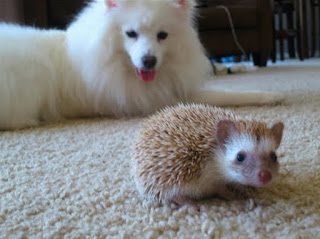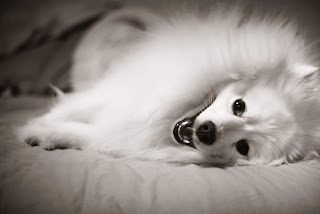- The American Eskimo was a popular circus dog in the early 20th century.
- The American Eskimo comes in three sizes: Toy, Miniature and Standard.
AKC : Non-sporting
UKC : Northern Breeds
Breed Group: Non-Sporting
Height:
Toy: 9–12 inches and 6–10 lbs
Miniature: 12–15 inches and 10–17 lbs
Standard: 15–20 inches and 18–25 lbs
Weight: 7 to 10 pounds; 11 to 20 pounds; 20 to 40 pounds
Life Span: 12 to 15 years
Coat: The American Eskimo Dog has a two-layered coat. The undercoat is short and dense, and the outer coat consists of long straight hair. The coat is thicker and longer around the chest and neck, giving the appearance of a mane. American Eskimo Dogs must be white or biscuit cream–any other color is unacceptable. The American Eskimo Dog sheds twice a year.Comparable Breeds: Alaskan Malamute, Samoyed
History
The American Eskimo Dog undoubtedly descended from several European spitz breeds, including the white Keeshond from Holland, the white German Spitz, the white Pomeranian from Germany and the Volpino Italiano, or white Italian Spitz. During the middle part of the 19th century, small, white Nordic-type dogs were common in American communities of German immigrants. Collectively, these dogs became referred to as the American Spitz. This spunky breed gained extreme popularity for use as trick dogs in traveling circuses across the United States. Supposedly, an American Eskimo named Stout’s Pal Pierre walked on a tightrope in the Ringling Bros. and Barnum & Bailey circus. The public loved seeing their sparkling white coats and quickness, while trainers prized them for these attributes along with their inherent intelligence, agility and trainability.
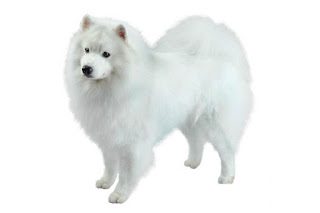
Although the reason is not clear, the American Spitz was renamed the American Eskimo in 1917. This modern title mistakenly suggests that these are miniature versions of larger sled-pulling dogs developed in the far northern parts of this continent. The change from “Spitz” to “Eskimo” may be explained by the political climate in the United States during World War I. “Spitz” is a German work that means “sharp point” and was used to describe northern dogs with pointed muzzles, erect ears, curled tails and double coats, and it has been suggested that the name change was an attempt to distance the breed in America from its German origins.
 The national parent club for the breed, the American Eskimo Dog Club of America (AEDCA), was formed in 1985 and opened its studbook in 1986. The AEDCA transferred its studbook to the American Kennel Club in 1993, with more than 1,750 Eskies registered as foundation stock. The American Eskimo Dog became part of the AKC’s Non-Sporting Group and fully recognized in 1995. Eskies are competitive in obedience, agility, rally and the conformation show ring. They are used as narcotics detection dogs and even guard dogs. While popular in the United States, this breed is little-known in other countries.
The national parent club for the breed, the American Eskimo Dog Club of America (AEDCA), was formed in 1985 and opened its studbook in 1986. The AEDCA transferred its studbook to the American Kennel Club in 1993, with more than 1,750 Eskies registered as foundation stock. The American Eskimo Dog became part of the AKC’s Non-Sporting Group and fully recognized in 1995. Eskies are competitive in obedience, agility, rally and the conformation show ring. They are used as narcotics detection dogs and even guard dogs. While popular in the United States, this breed is little-known in other countries.
Personality
The Eskie is smart, friendly and a good communicator. His alert nature makes him an excellent watchdog, but beware! He is highly vocal. Train him from a very early age that excessive barking isn’t permitted.
An American Eskimo will let you know what he wants through glances and barks. A look at the cookie jar, followed by a look at you and a look back at the jar sends a very clear message. Hypnotized by his dark eyes and smiling face, you’ll find yourself mindlessly handing him a treat.
The Eskie gets along with most everyone he meets, but he’s not always patient with tight squeezes from children. Closely supervise interactions with young children, and teach them how to pet the Eskie gently. An American Eskimo should never be shy or aggressive. Say no thanks if a puppy or his parents aren’t approachable.
Start training your puppy the day you bring him home. Even at eight weeks old, he is capable of soaking up everything you can teach him. Don’t wait until he is 6 months old to begin training or you will have a more headstrong dog to deal with. If possible, get him into puppy kindergarten class by the time he is 10 to 12 weeks old, and socialize, socialize, socialize. However, be aware that many puppy training classes require certain vaccines to be up to date, and many veterinarians recommend limited exposure to other dogs and public places until puppy vaccines have been completed. In lieu of formal training, you can begin training your puppy at home and socializing him among family and friends until puppy vaccines are completed.
Talk to the breeder, describe exactly what you’re looking for in a dog, and ask for assistance in selecting a puppy. Breeders see the puppies daily and can make uncannily accurate recommendations once they know something about your lifestyle and personality. Whatever you want from an Eskie, look for one whose parents have nice personalities and who has been well socialized from early puppyhood.
Health
The American Eskimo is a hardy breed with an average life span of 12–15 years.This breed tends to become overweight easily, so proper diet and exercise is needed to maintain an overall well being. Health testing should be performed by all responsible breeders and anyone purchasing a puppy should be aware of the genetic problems which have been found in some individuals of the breed, such as PRA (Progressive Retinal Atrophy), luxating patella, and hip dysplasia). None of these problems are common and the breed is generally very healthy. In addition to the rarer problems mentioned, the breed can have a tendency towards allergies and most commonly, tear-staining. This breed also is known in some cases to have dental issues.
The standard American Eskimo Dog needs a good workout every day and should be taken for a long jog or walk. Provide plenty of water and shade during exercise to avoid overheating from the heavy coat. Eskies enjoy dog sports. Without interaction they may become bored and destructive.
Care
All Eskies love cold weather. However, because they create close attachments to their human family, they should be allowed to live indoors. The Eskie’s double coat must be combed and brushed twice a week, more during its shedding periods. The Eskie is also very energetic and requires a vigorous workout daily, although the duration of the workout is determined by the dog’s size. For example, a larger Eskie requires a long walk or brisk jog, while short walks or a fun outdoor game are sufficient forms of exercise for smaller Eskies.
Living Conditions
The American Eskimo will do okay in an apartment if it is sufficiently exercised. It is very active indoors and a small yard will be sufficient.
Training
There are a few reasons why the American Eskimo Dog was used in circuses. Easily trainable, the Eskie loves to learn tricks. You’ll need to take the leadership role fast, because when this breed senses it can take control over the situation, it will take it. And because it is so intelligent, it will sense when confident leadership is lacking. To get the best results out of training, use positive reinforcement. Once you’ve completed basic training, be sure to enroll your dog in more advanced courses – it will help to stimulate your dog’s mind.
The American Eskimo Dog is a natural born watchdog, so there’s no training necessary. And even though this breed is a watchdog, it will not develop aggressive traits. Start training as soon as possible for the best results.
Grooming
The Eskie has a double coat: a dense undercoat topped by longer guard hairs. He has a ruff around the neck, which is more prominent on males than on females. The backs of the legs and the tail are also furry.
Brush the Eskie’s straight, thick coat a couple of times a week to prevent or remove mats and tangles. Plan to brush it more often when he’s shedding to keep loose hair off your clothes and furniture. You’ll need a slicker brush, pin brush and metal Greyhound comb. Bathe the Eskie about every three months.
The rest is basic care. Trim the nails as needed, usually every few weeks, and brush the teeth frequently for good overall health and fresh breath.
Children And Other Pets
The Eskie is an excellent family dog who’s affectionate with everyone, including kids of all ages, other dogs, and cats. Of course, adults should always supervise interactions between kids and dogs; the Eskie’s high energy level can be overwhelming to extremely young children, so supervision is especially important.
The Eskie does not receive high marks for living in peace with small mammals and birds, which he tends to chase.
Is this breed right for you?
An active and intelligent breed, the American Eskimo Dog requires a lot of attention and firm training. Doing well with kids and animals, this working dog enjoys being busy. Not recommended for apartment life, the Eskie needs a lot of daily exercise and a yard to play freely in.
It’s essential that he receives training, firm leadership and attention. If not, it’s likely that the Eskie will act out and display negative behaviors. A true watchdog, he will protect the family from strangers but is happily friendly with family members and friends. In need of a lot of grooming, this breed needs twice-weekly to daily brushing.
Did You Know?
The American Eskimo breed was developed by 19th-century German immigrants in the United States and was known for a while as the American Spitz
A dream day in the life of a American Eskimo Dog
An alert breed, it’s likely the American Eskimo Dog will be awake before any other family members. Out the door to scour the yard for any intruders or to work the farm, this breed will be happy to trot around until he hears someone in the kitchen. After his daily walk, the Eskie will be happy to receive a bit of petting and praise. Playing around with the kids, he’ll keep himself busy going in and out of the house. Lying at the foot of his master at the end of the day, the Eskie will keep his ears up all night for anything that doesn’t sound right.
 The national parent club for the breed, the American Eskimo Dog Club of America (AEDCA), was formed in 1985 and opened its studbook in 1986. The AEDCA transferred its studbook to the American Kennel Club in 1993, with more than 1,750 Eskies registered as foundation stock. The American Eskimo Dog became part of the AKC’s Non-Sporting Group and fully recognized in 1995. Eskies are competitive in obedience, agility, rally and the conformation show ring. They are used as narcotics detection dogs and even guard dogs. While popular in the United States, this breed is little-known in other countries.
The national parent club for the breed, the American Eskimo Dog Club of America (AEDCA), was formed in 1985 and opened its studbook in 1986. The AEDCA transferred its studbook to the American Kennel Club in 1993, with more than 1,750 Eskies registered as foundation stock. The American Eskimo Dog became part of the AKC’s Non-Sporting Group and fully recognized in 1995. Eskies are competitive in obedience, agility, rally and the conformation show ring. They are used as narcotics detection dogs and even guard dogs. While popular in the United States, this breed is little-known in other countries.

